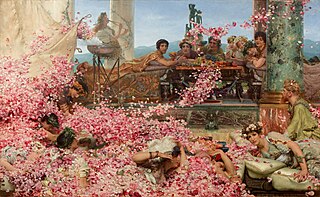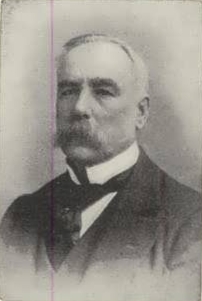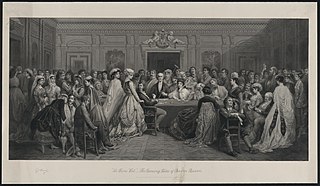
Sir Lawrence Alma-Tadema was a Dutch painter who later settled in the United Kingdom, becoming the last officially recognised denizen in 1873. Born in Dronryp, the Netherlands, and trained at the Royal Academy of Antwerp, Belgium, he settled in London, England in 1870 and spent the rest of his life there.

The Roses of Heliogabalus is an oil painting by the Anglo-Dutch artist Sir Lawrence Alma-Tadema, from 1888. It depicts the young Roman emperor Elagabalus hosting a banquet. It is held in a private collection.

William Powell Frith was an English painter specialising in genre subjects and panoramic narrative works of life in the Victorian era. He was elected to the Royal Academy in 1853, presenting The Sleeping Model as his Diploma work. He has been described as the "greatest British painter of the social scene since Hogarth".

Alfred Elmore (1815–1881) was a British history and genre painter.

John William Godward was an English painter from the end of the Neo-Classicist era. He was a protégé of Sir Lawrence Alma-Tadema, but his style of painting fell out of favour with the rise of modern art.

Jean Joseph Ernest Theodore Gambart was an English art publisher and dealer who dominated the London art world in the middle of the nineteenth century.

Spring is an 1894 oil-on-canvas painting by the Anglo-Dutch artist Lawrence Alma-Tadema, which has been in the collection of the J. Paul Getty Museum in Los Angeles, California, since 1972. The painting relates the Victorian custom of children collecting flowers on May Day back to an Ancient Roman spring festival, perhaps Cerealia or Floralia or Ambarvalia, although the details depicted in the painting do not correspond to any single Roman festival. It was the inspiration for the scene of Julius Caesar's triumphal entry into Rome in the 1934 film Cleopatra.

Laura Sylvia Gosse was an English painter and printmaker. She also ran an art school with the painter Walter Sickert.
Peter Trippi is editor-in-chief of Fine Art Connoisseur, a bimonthly magazine for collectors of representational painting, sculpture, drawings and prints—both historical and contemporary. From 2003 until 2006, Trippi was director of New York City's Dahesh Museum of Art, the only institution in the United States devoted to 19th- and early 20th-century European academic art.

A Private View at the Royal Academy, 1881 is a painting by the English artist William Powell Frith exhibited at the Royal Academy of Arts in London in 1883. It depicts a group of distinguished Victorians visiting the Royal Academy Summer Exhibition in 1881, just after the death of the Prime Minister Benjamin Disraeli, whose portrait by John Everett Millais was included on a screen at the special request of Queen Victoria. The room is Gallery III, the largest and most imposing room at Burlington House.

John Reinhard Weguelin was an English painter and illustrator, active from 1877 to after 1910. He specialized in figurative paintings with lush backgrounds, typically landscapes or garden scenes. Weguelin emulated the neo-classical style of Edward Poynter and Lawrence Alma-Tadema, painting subjects inspired by classical antiquity and mythology. He depicted scenes of everyday life in ancient Greece and Rome, as well as mythological subjects, with an emphasis on pastoral scenes. Weguelin also drew on folklore for inspiration, and painted numerous images of nymphs and mermaids.

Laura Theresa, Lady Alma-Tadema was a British painter specialising in domestic and genre scenes of women and children. Eighteen of her paintings were exhibited at the Royal Academy. Her husband, Sir Lawrence Alma-Tadema, was one of the most prominent Victorian painters.

Henrietta Emma Ratcliffe Rae was a British painter of the late Victorian era, who specialised in classical, allegorical and literary subjects. Her best-known painting is The Lady with the Lamp (1891); depicting Florence Nightingale at Scutari.

Anna Alma-Tadema was a British artist and suffragette.

The Derby Day is a large oil painting showing a panoramic view of The Derby, painted by the English artist William Powell Frith over 15 months from 1856 to 1858. It has been described by Christie's as Frith's "undisputed masterpiece" and also "arguably the definitive example of Victorian modern-life genre."

Henry Jamyn Brooks (1839–1925) was a British painter, particularly known for his pictures of meetings and events, in which many individuals are personally identifiable. He painted royalty, and portraits of civic leaders and military people, and was also a photographer.

Ramsgate Sands, also known as Life at the Seaside, is an oil-on-canvas painting by the English artist William Powell Frith, who worked on it from 1851 to 1854. The painting, which depicts a beach scene in Ramsgate, was Frith's first great commercial success: it was exhibited at the Royal Academy summer exhibition in 1854, and bought by Queen Victoria. Frith made a series of similar pictures, showing groups of people in contemporary scenes, including The Derby Day of 1858, The Railway Station of 1862, and Private View at the Royal Academy of 1883.

The Finding of Moses is a oil-on-canvas painting by the Anglo-Dutch artist Lawrence Alma-Tadema, from 1904. It was one of his last major works before his death in 1912, but quickly fell out of favour; according to rumour, it was sold in the 1950s for its frame. After appreciation of Victorian painting was renewed towards the end of the 20th century, it was described in an auction catalogue in 1995 as "the undisputed masterpiece of [Alma-Tadema's] last decade, as well as a late flowering of the nineteenth-century's love-affair with Egypt". It was sold to a private collector at auction in 2010 for nearly US$36 million.

Salon D'Or, Homburg, is an 1871 oil painting by William Powell Frith. It is held by the Rhode Island School of Design Museum in Providence, Rhode Island.

A Reading from Homer is an oil-on-canvas painting executed in 1885 by the English artist Lawrence Alma-Tadema. It depicts an imaginary festival scene from ancient Greece with youth reading poetry to a small audience on a marble balcony overlooking the sea. The painting has been in the collection of the Philadelphia Museum of Art since 1924.



















